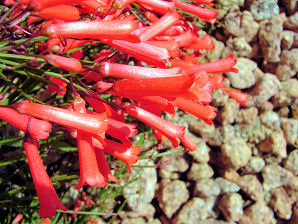Xeriscape Landscaping Plants For The Arizona Desert Environment.
Pictures, Photos, Information
Descriptions, Images, & Reviews.
Shrubs.
Coral Plant, Russelia equisetiformis.
We Are Proud Of Our SafeSurf Rating!
Click On Any Of The Following Links By Amazon.Com
For Books, & Videos About Wildflowers Of Arizona & The Southwest USA. No Obligation!
 |
| Coral Plant, Russelia equisetiformis. Photo Taken March 20, 2008. Glendale, Arizona. |
|---|
 | |
| Coral Plant Flowers. Russelia equisetiformis. | Coral Plant Flower. Russelia equisetiformis. |
|---|
Coral Plant.
We wish to thank Wikipedia, the free encyclopedia for some of the information on this page. We share images and information with Wikipedia. Russelia equisetiformis is a fast growing, easy to cultivate, perennial, evergreen shrub, native to Mexico. It blooms almost continuously making it a must have plant for our desert butterfly gardens. It has slender, rushlike stems that are angled with ridges and with leaves that are little more than small scales. It has wiry looking branches that start out erect then fall over to form a cascade downward about 4 - 6 feet in length. Firecracker Plant produces long hanging clusters of scarlet tubular flowers about 1 inch in length from Spring until Fall, that look like small firecrackers, giving it the other common name, firecracker plant. If placed in containers Coral Fountain produces movement in the garden. Coral Fountain grows best in well-drained soil with full sun to partial shade. It uses more water than most Xeriscape plants but would be a good addition into a Xeriscape garden.
Quick Notes:
Height: Up to 3- 4 feet feet tall and up to 6 feet wide.
Flowers: Scarlet tubular flowers about 1 inch in length.
Flowering Time: Mid -March to November.
Leaves: Green, slender, rushlike stems that are angled with ridges and with leaves that are little more than small scales.
Found: The USDA claims it is native to theUSA (FL), USA+ (PR, VI). It is also native to central & tropical Mexico into South America.
Hardiness: Root hardy to 20 �F
Soil pH requirements:
Sun Exposure:
Elevation: Naturally found between 0 to 3,800 feet.
Habitat: Native to Mexico. Chihuahuan desert, sandy desert soils. Also on cultivated, waste and fallow land, roadsides, & yards.
Miscellaneous: Flowering Photos Taken March 20, 2008. Glendale. Hardy to about 25 �F.
|
We Are Proud Of Our SafeSurf Rating!
Click On Any Of The Following Links By Amazon.Com
For Books, & Videos About Wildflowers Of Arizona & The Southwest USA. No Obligation!
| © 1966 - Present, Audrey, Eve, & George DeLange |
